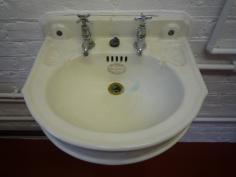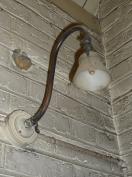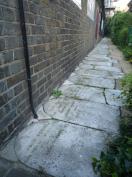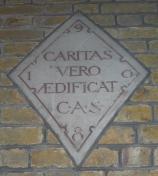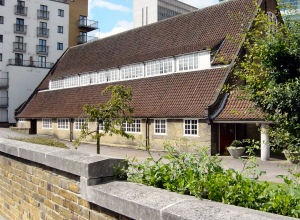
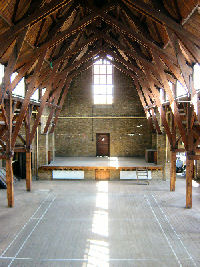
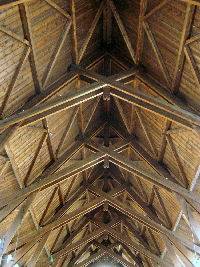

About the Adult School Hall
The Adult School Hall belongs to the Religious Society of Friends in Britain and adjoins the current Quaker meeting house. When it was opened in 1908 there were nearly a thousand members in the Croydon branch of Adult School Movement founded by Theodore Crosfield, a 19th-century Quaker. The previous meeting house of 1820, destroyed by a land mine in 1940, adjoined the Adult School Hall at its east wall, and the foreground area was a Quaker burial ground before the road-widening of 1967. Its simple headstones were re-laid horizontally as a path along the western side (not visible from Park Lane) of the Adult School Hall, and the burial remains themselves transferred to the Queen's Road Cemetery.
In this photograph
of the headstones it is just possible to make out the inscription on the first one:
John Squire who died 20th of 10th month [year illegible] aged
[illegible] years
Note two Quakerly aspects: absolute uniformity of text - Quakers are equal in death as in
life - and "10th month" - the month names are all heathen.
Following the 1940 destruction of the old meeting house the hall was used for meetings for worship until 1944, when it was requisitioned for accommodation for bombed-out residents and as a refugee centre. Meetings for worship were resumed at the end of the war and continued until the present meeting house was opened in January 1957. Four of the carved benches that originally belonged to the old meeting house still remain as a link with the past: three are in the Adult School Hall and the fourth is now situated under the first noticeboard on the left of the main meeting house entrance hall. (Try it - it's surprisingly comfortable!)
The Hall has since been used for various functions, including Nightwatch, the Woodcraft Folk, and as a venue for Croydon Friends' annual jumble sales. More recently it has found favour as a striking film location. Croydon Quakers are keen to secure further uses for the building on a short- or long-term basis.
We will be delighetd to accept bookings for both the Meeting House and the Adult School Hall for evening meetings. (Both are fully booked at present for daytime use.) Please email Croydon Quakers Office with your requirements.
Architectural features
Based, with kind permission, on an article by Joseph Mirwitch in the Twentieth Century Society Newsletter, Winter 2006/7
The Hall was designed by William Curtis Green (1875-1960), who later contributed designs to Hampstead Garden Suburb (from 1905), Letchworth Garden City (from 1902), municipal housing at Winchester (1919), and - his largest project (1930) - the Dorchester Hotel in Park Lane, Mayfair. He was president of the Architectural Association (1913-14), vice-president of the RIBA (1923-4) and elected to the Royal Academy in 1933. Curtis Green obtained the commission for a hall to seat 900 people through the connections of his wife, herself a member of the prominent Quaker family of Crosfield. The cost of the building was donated by Theodore Crosfield.
The walls are constructed of local brick; Roman pantile clad roof; timber casement windows; and the flooring is natural pine boarding. Pine columns supporting the scissor trusses of the fine open timber roof, which is double square in plan, define the floor space into an airy central 'nave' with two side 'aisles'. The thin wooden scissor trusses of the roof are arranged in elegant geometrical forms.
In a lecture of 1912 Curtis Green clarified his intention of working within a continuing tradition of building design and construction whilst accepting and improving modern innovation which remains rooted in that tradition. The design is characterised by its manifest 'plainness and honesty' - an architectural expression of Quaker testimonies. Truly remarkable are the total absence of applied finishes and the complete 'honesty of materials'. The design also embraces the principle of 'honesty of expression' in that the function of all parts and their purpose is explicit. For example, it is clear to the viewer which parts of the roof structure are load-bearing. Nothing is concealed; there are no hidden inner parts; no façades whatsoever. All ostentatious embellishment and extravagant decoration is eschewed, again a Quaker principle.
This building remains in a remarkably original and unaltered condition, all the finishes remaining as designed. Of the few significant changes made since, one is the loss of the original hanging lights, which were in the shape of iron 'cart tyres'. For an early 20th century building of this size to be in so unaltered a state and still with its original finishes is an extremely rare and very fortunate survival.
Over the original south entrance (now virtually inaccessible) is
this
date stone
bearing the inscription Caritas vero ædificat -
C·A·S - 1908.
C·A·S is presumably Croydon Adult School. The Latin is the end of
1st Corinthians 8:1
in the Vulgate: de his autem quae idolis sacrificantur scimus quia omnes scientiam habemus
scientia inflat caritas vero aedificat. Which the KJV translates as now as
touching things
offered unto idols, we know that we all have knowledge. Knowledge puffeth up, but charity
edifieth. "Love builds up" is possibly a better translation for
"caritas vero ædificat".
Listing for the hall in the English Heritage register.
Text and photography by David Parlett (Keeper of Records, Croydon Local Quaker Meeting) and Roger W. Haworth


